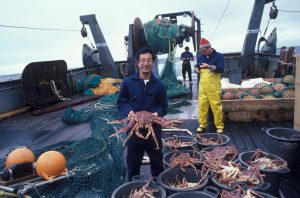King Crab Hatcheries in Alaska
 Western Alaska has been hit hard economically by the long-term decline in crab stocks. This year, the Bering Sea snow crab total allowable catch was reduced by 90 percent while the Bristol Bay red king crab fishery has been closed entirely. This week, changes were made to House Bill 41, a bill allowing designated non-profits to grow shellfish in hatcheries, moving the bill closer to becoming a law. HB 41 has now passed the Legislature; next, it will move to Gov. Dunleavy’s desk for signing.
Western Alaska has been hit hard economically by the long-term decline in crab stocks. This year, the Bering Sea snow crab total allowable catch was reduced by 90 percent while the Bristol Bay red king crab fishery has been closed entirely. This week, changes were made to House Bill 41, a bill allowing designated non-profits to grow shellfish in hatcheries, moving the bill closer to becoming a law. HB 41 has now passed the Legislature; next, it will move to Gov. Dunleavy’s desk for signing.
This bill would allow for select non-profit organizations to carry out restoration and enhancement projects for specific shellfish species like king crab, sea cucumbers, abalone, and razor clams. Organizations would utilize hatcheries to raise then release shellfish into Alaskan seas in an effort to support and seed commercial fishing in the region.
“HB 41 plays a key role in the building blocks to make mariculture a growing and significant part of the overall Alaska fisheries portfolio,” said Dan Ortiz, an independent Alaska representative who originally presented the bill in February, 2021.
Safety standards and a framework for managing projects has been outlined for implementation by the Alaska Department of Fish and Game. The goal of the project is to grow and keep shellfish stocks healthy for future generations.
“There’s lots of other things that have already happened and need to continue to happen in order to make that dream of perhaps an added billion-dollar-a-year industry to an already $5 billion, $6 billion-a-year industry.”
The current capital budget for new mariculture is $5 million. Ortiz would like to see that budget increased.
“One thing that I’d like to see before the session ends is to see if we can get that number closer to the $25 million requested,” Ortiz said.
Building crab and shellfish hatcheries may seem like a prudent way to increase stocks, but some Alaska biologists have reservations and feel more research is in order. They’re particularly concerned about crab, one of the more mobile shellfish species. There are genetic concerns such as inbreeding, and the effects cultured releases may have on other species and their habitat. King Crab are long lived and harvest takes place at 7 to 9 years of age, making the size of the population to sustain a fishery substantial. In contrast, salmon are relatively short-lived and can be harvested earlier, some as early as 18 months, especially pink and chum salmon.
This shellfish restoration project is still in the early stages of research, policy development, and permitting, but the advantages to the industry, local economies, and future generations are very promising.
 Maritime Injury Law Blog
Maritime Injury Law Blog

